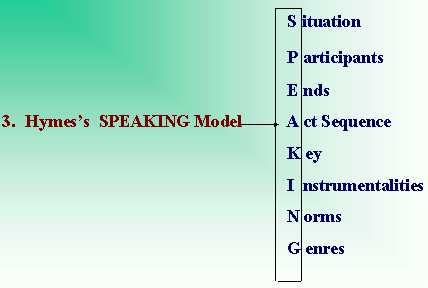A.
Background
Basically the language is an integral part of a social system. Human
communication that can convey information to each other in the form of
thoughts, ideas, intentions, feelings, and emotions directly. The sosiolinguis
question the existence of language variation of various levels that are clearly
not a mere performance as a result of conditions grammatically irrelevant, but
their actually caused by a variety of factors multilingual as a reflection of a
community language that is always heterogeneous.
In any event in verbal interaction or communication process there
is always some components that take part and be involved in the incident. Bell
(1976) states traditionally there are three components that have long been
recognized as a major component of an event or situation, namely communication:
speakers, the hearer, and the topic of conversation. In other words, in every
process that occurs between the speaker and the speech occurs opponents also
said the so-called incident or event language (speech event). This paper will
discuss the analysis ethnography of communication (Ethnography of
Communication) initiated by Dell Hymes said covering events (speech event) and
the rules that mark the occurrence of an event of speech or language events.
B.
Literatur Review
Sociolinguist Dell Hymes developed the following model to promote
the analysis of discourse as a series of speech events and speech acts within a
cultural context. It uses the first letters of terms for speech components; the
categories are so productive and powerful in analysis that you can use this
model to analyze many different kinds of discourse. The eight components of the
speaking model are:
1.
Setting and
Scene
"Setting refers to the time
and place of a speech act and, in general, to the physical circumstances"
(Hymes 55). Scene is the "psychological setting" or "cultural
definition" of a scene, including characteristics such as range of
formality and sense of play or seriousness (Hymes 55-56).
2.
Participants
Speaker and audience. Linguists
will make distinctions within these categories; for example, the audience can
be distinguished as addressees and other hearers (Hymes 54 & 56).
3.
Ends
Purposes, goals, and outcomes
(Hymes 56-57).
4.
Act Sequence
Form and order of the event.
5.
Key
Cues that establish the
"tone, manner, or spirit" of the speech act (Hymes 57).
6.
Instrumentalities
Forms and styles of speech (Hymes
58-60).
7.
Norms
Social rules governing the event
and the participants' actions and reaction.
8.
Genre
The kind of speech act or event;
for our course, the kind of story.
These terms can be applied to many kinds of discourse. Sometimes
in a written discussion you might emphasize only two or three of the letters of
the mnemonic. It provides a structure for you to perceive components.
C.
Discussion and Analysis Data
The writer wanted to know whether the theory speaking of Dell
Hymes can prove events that occur in the dialogue said the conversation, but
because of the mixing of language that allows the need for proving the theory
speaking of Dell Hymes. Sustainability of linguistic interaction in a speech
that involves two or more parties, the speaker and the person said, with one
principal speech, in time, place and specific situations. The authors analyze
the theory of speaking as follows :
Data :
Mr.Brown : Good
morning, sir.
Mr.Bonar : Good morning
Mr.Brown : I
would like to go to Madani hotel
Mr.Bonar : Oh, hotel Madani, I
know it
Mr.Brown : How
long to go there?
Mr.Bonar : From here Kualanamu,
one hour to Madani
Mr.Brown :
(interruption) What about a half hour?
Mr.Bonar : No,
busy sir
Mr.Brown : Ok.
How much?
Mr.Bonar :
Rp.100.000,-
Mr.Brown : Yes,
let’s go
Analysis Data
The Speaking model by Dell Hymes
1.
Setting and
Scene
The Foreigner’s and Batakness
driver’s conversation, is at Kualanamu
International Airport. At times, the Foreigner and Bataknese driver would be
festive and at other times serious
2.
Participant
At the conversation, the
foreigner Mr.Brown told the driver Mr.Bonar his direction, to Madani hotel.
3.
Ends
The driver gave information and
show the direction to the Madani hotel to the foreigner.
4.
Act Sequence
:
While Mr.Bonar told that it took
one hour to Madani hotel, Mr.Brown interrupted him by asking to drive there for
a half hour.
5.
Key :
Mr.Bonar might immitate
Mr.Brown’s voice and gestures or he might address him in serious voice
emphasizing the reality of the distance.
6.
Intent :
Mr.Brown went to the Madani hotel
for attending a Seminar.
7.
Norms :
A conversation between a
foreigner and a driver might be with interruption but politely, or might not be
lying as norms .
8.
Genre :
The kind of speech act or event
used here, the dialog. The driver might tell the distance and the cost to
Madani hotel for information, or polite responses as moral attitudes.
D.
Conclusion
From the above analysis it can be concluded that the entire
conversation between Mr. Brwon with Mr. Bonar (driver) just to use the services
of a driver and the information about the place. The atmosphere was visible
from almost all the talks marred by friendly and courteous.
Indeed, there is a sentence that is not perfect, it is sometimes
difficult to be labeled. It is also acceptable in oral conversation because the
context of the conversation and paralinguistic elements is helpful to
understand illocutionary respectively.
Context is crucial in understanding and interpreting the
discourse. Context that can not be overlooked when people try to get the real
meaning of information is heard or read. Define
the context in understanding the discourse of course by providing
interpretation of SPEAKING (setting, participant, end, act sequences, key,
instrument, norm, and genre).
Now that you have learned Hymes' S.P.E.A.K.I.N.G. model, and have
read one example, you should be able to apply it to a situation.
E.
Bibliography
Bell, T. Roger. 1976. Sociolingistics: Goals, Approaches and
Problems. London: B.T. Batsford Ltd.


Judul bukunya apa ya?
BalasHapusconversationnya bahan sendiri
Hapus